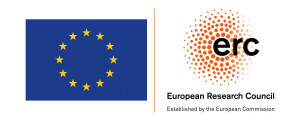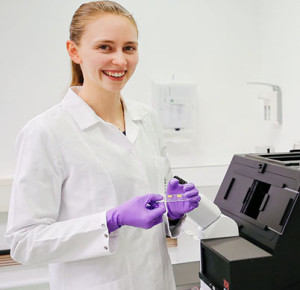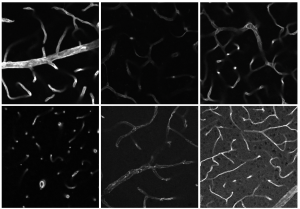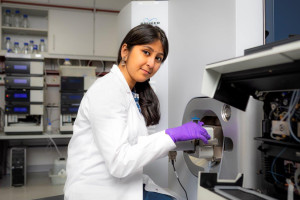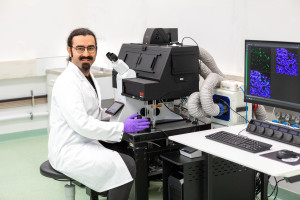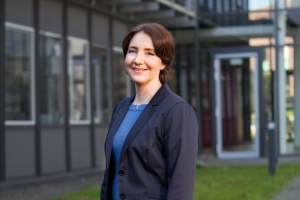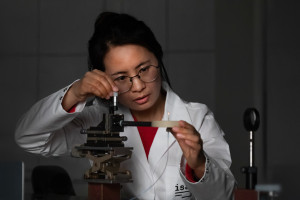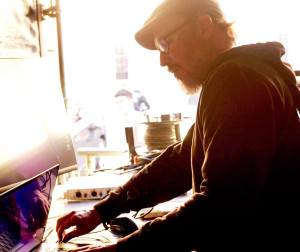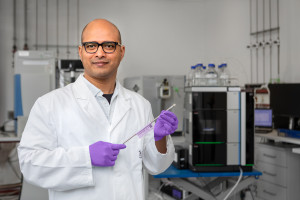Dortmund, 6th May 2022
Her colleagues in the ERC group Sulfaging affectionately call Dunja Petrovic (27) the “worm lady”. For she has been spending a lot of time with nematodes since starting her PhD in Bordeaux, France, in 2018, and has been continuing at ISAS since 2020. Petrovic’s daily routine in the lab and her free time revolve around Caenorhabditis elegans, C. elegans for short. In the interview, the PhD student talks about why the mutant roundworms help the Serbian to research ageing processes in humans and which new developments the laboratory change to Dortmund entailed.
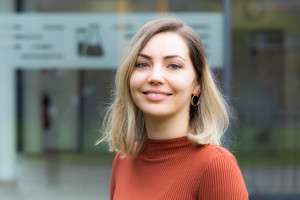
At ISAS, Dunja Petrovic studies the effects of hydrogen sulfide on the body's ageing process.
© ISAS / Hannes Woidich
What is the subject of your dissertation?
Petrovic: I deal with hydrogen sulfide, H2S for short. We know that it influences many important processes in our body, such as ageing. I pose the question which effect the absence of enzymes that produce H2S in the body has on the organism. For that, I use the model organism C. elegans. For my research, I can “switch off” the genes that contain information for these enzymes in wildtype roundworms. With these so-called mutant worms, I analyse how the lack of a certain protein product influences their development or stress response. For example, I look at their lifespan or examine how sensitively the worms react to different environmental stimuli. That is part of my research work.
The European Research Council awarded the leader of your working group, Dr habil Milos Filipović, with two million euros in funding. What is the aim of your working group?
Petrovic: Ageing processes lie at the heart of our group’s research. As we age, the proteins in our body are more prone to irreversible oxidation. The reason for that is the contact with hydrogen peroxide and other oxidising agents, by-products of our metabolism, whose amount increase with ageing. On the other hand, our defence mechanisms become less efficient. H2S comes into play here. This gas can react with oxidised cysteines and form persulfides. We believe that this process, called persulfidation, prevents protein overoxidation and therefore preserves its function. I want to understand how the persulfidome of a cell and a whole organism, changes during ageing. For example we were able to show that the levels of persulfidation decrease with age in different model systems. This phenomenon might be one of the many reasons why we get old.
Can you transfer the results of your work with worms to humans?
Petrovic: Biologically speaking, the worms are much simpler than humans are, of course. However, we are able to understand some of the fundamental signalling pathways in the body because of them and then build on these findings. Time plays a decisive role here. Unlike mammals, where several years go by before they start ageing, C. elegans only takes three days to develop from an egg to an adult animal. During their two to three week lifespan, we can track their whole ageing process. It is like watching an old person through a microscope. The animals move less than at the beginning of their adulthood and their bodies look almost wrinkly.
What is special about working with these worms?
Petrovic: The worms are easy to keep and with a size of only about one millimetre, they are very small. They develop fast, so I get results from a multitude of animals in a short amount of time. That is not only convenient, but also makes the reproducibility of findings easier. Another significant advantage is that C. elegans is already well researched. There is a big database, known as WormBase, with almost all possible mutations and relevant information. It is an exciting field of study and a positive way of interacting, because the whole ‘worm community’ works together closely and shares many of the results and insights about C. elegans. For me, the roundworms are a full-time job: when experiments run for several days, I cannot just stop or get on with other things. Often, everything revolves around the worms – even in my free time.
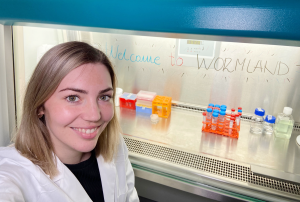
During the growth phase of C. elegans, Dunja Petrovic spends countless hours in the lab so that she can closely study the nematodes' development. With a joke, the doctoral student refers to her workplace as wormland.
© Privat
Funding of Sulfaging
This project has received funding from the European Research Council (ERC) under the European Union’s Horizon 2020 research and innovation programme (grant agreement No 864921).
How did you first become interested in your research area?
Petrovic: I wanted to do my PhD abroad from the outset and I heard that my current working group leader had a free doctorate position. The project Sulfaging immediately inspired me, as I had already worked on neurodegenerative diseases in Serbia. I found it fascinating to study the biochemical processes alongside the genetic aspects, which I know well from molecular biology studies. However, I had only worked with human blood samples before. Working with living organisms like C. elegans was a new experience for me. In Bordeaux, where our working group did their research before, there was a worm expert. I learned a lot from her. It took a little time for me to be able to reliably identify the different stages of development and handle the tiny animals. By now, I teach the handling of C. elegans to others.
What did moving to ISAS mean to you and to your research?
Petrovic: When we moved to Dortmund in October 2020, I was at the end of the second year of my PhD. Here, we did not only have to re-accustom ourselves, but also re-built from the ground up. That was difficult at first and cost a lot of time. It was worth it in the end, though, because we have a lot of opportunities at ISAS that we would not have anywhere else. Here, we can use many different methods of analysis and work in collaboration with the other working groups. For example, we have been lately focused on developing and optimising our method for proteomics analyses. With these, we do not only get an insight into the protein persulfidation and its dynamics under different conditions, but also into the total cell proteome. This powerful data enables us to get a much bigger picture of processes happening inside the cell. Thus, we can understand ageing processes on a broader scale. We also use imaging techniques such as fluorescence microscopy. At ISAS City, we use the confocal microscope to localise regions of the cells or worms of interest. With these methods, we can see how pronounced the levels of persulfidation are in different regions of the worms’ bodies.
Your PhD is drawing toward an end. What are your plans for the time afterwards?
Petrovic: I definitely want to stay in research. Milos Filipović taught me the importance of loving what you do. I like being in the lab and enjoy my work. My career choice allows me to travel a lot and work in foreign countries. After my PhD, I want to tap into that and gain experience in different laboratories before I settle in one place.
(The interview has been conducted by Cheyenne Peters)
Article Recommendation
Petrovic D, Kouroussis E, Vignane T, Filipović M. The Role of Protein Persulfidation in Brain Aging and Neurodegeneration. Front. Aging Neurosci. 2021 Jun;13:674135. doi: 10.3389/fnagi.2021.674135
